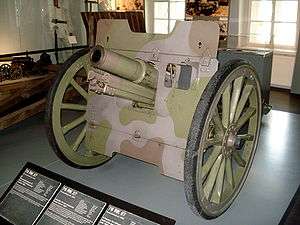76 mm regimental gun M1927
The 76 mm regimental gun M1927 (Russian: 76-мм полковая пушка обр. 1927 г.) was a Soviet infantry support gun. The gun was developed in 1927 by the design bureau of Orudiyno-Arsenalny Trest (OAT) and entered production in 1928. A total of 16,482 pieces were built. On June 22, 1941, the Red Army had 4,708 of these guns. In 1943 the gun was replaced in production by the 76 mm regimental gun M1943, but remained in service until the end of the war. The Germans placed captured guns into service as the 7.62 cm Infanteriekanonehaubitze 290(r) (infantry gun-howitzer), while in the Finnish army they were known as 76 RK/27.
| 76 mm regimental gun M1927 | |
|---|---|
 76 mm regimental gun M1927 in The Artillery Museum of Finland. | |
| Type | Infantry support gun |
| Place of origin | Soviet Union |
| Service history | |
| Used by | |
| Wars | Winter War World War II |
| Production history | |
| Produced | 1928–1943 |
| No. built | 16,482 |
| Specifications | |
| Mass | 780 kg (1,720 lb) |
| Length | 3.5 m (11 ft 6 in) |
| Barrel length | 1.25 m (4 ft 1 in) L/16.4 |
| Width | 1.7 m (5 ft 7 in) |
| Height | 1.3 m (4 ft 3 in)[1] |
| Shell | 76.2 × 167 mm R |
| Shell weight | 6.2 kg (13 lb 11 oz) |
| Caliber | 76.2 mm (3 in) |
| Breech | interrupted screw |
| Carriage | Pole trail |
| Elevation | -6° to 25° |
| Traverse | 6°[1] |
| Rate of fire | 10 - 12 rpm |
| Muzzle velocity | 387 m/s (1,270 ft/s) |
| Maximum firing range | 4.2 km (2.6 mi)[1] |
The gun was intended for destruction of light field fortifications and openly placed personnel by direct fire. HEAT shell gave it limited anti-tank capabilities.
The M1927 was issued to rifle and cavalry regiments of the Red Army. Artillery battalion of rifle brigade included one battery of M1927. Some guns were used by anti-tank artillery battalions.
Ammunition
- Ammunition types:
- Projectile weight:
- OF-350: 6.2 kg.
- Muzzle velocity:
- OF-350, O-350A: 262 m/s.
- BP-350M: 311 m/s.
- Effective range:
- OF-350, O-350A: 4,200 m.
- BP-350M: 1,000 m.
References
- Chamberlain, Peter (1975). Infantry, mountain, and airborne guns. Gander, Terry. New York: Arco. p. 61. ISBN 0668038195. OCLC 2067391.
External links
| Wikimedia Commons has media related to 76.2-mm regimental gun M1927. |
- Chamberlain, Peter & Gander, Terry. Infantry, Mountain and Airborne Guns. New York: Arco, 1975
- Gander, Terry and Chamberlain, Peter. Weapons of the Third Reich: An Encyclopedic Survey of All Small Arms, Artillery and Special Weapons of the German Land Forces 1939-1945. New York: Doubleday, 1979 ISBN 0-385-15090-3
- Ivanov A. - Artillery of the USSR in Second World War - SPb Neva, 2003 (Иванов А. Артиллерия СССР во Второй Мировой войне. — СПб., Издательский дом Нева, 2003., ISBN 5-7654-2731-6)
- Shunkov V. N. - The Weapons of the Red Army, Mn. Harvest, 1999 (Шунков В. Н. - Оружие Красной Армии. — Мн.: Харвест, 1999.) ISBN 985-433-469-4
- 76.2-mm Regimental gun model 1927 on the BattleField.Ru
